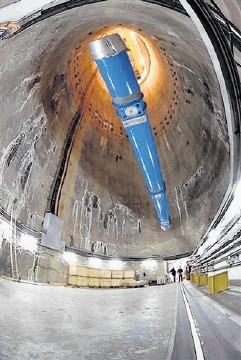
What do finding the Higgs Boson, Monte Carlo and a novel method to allocate North Sea oil and gas have in common?
All are informed by the mathematics of risk, probability and uncertainty.
With potential Nobel prizes in the offing, the detection of the Higgs particle in the Large Hadron Collider at CERN was only announced when it could be stated with a high level of certainty.
The Higgs particle cannot be observed directly but its presence can be inferred from other particles produced by its decay – the specific combination of these decay particles is in effect the Higgs’ signature.
The trouble with observing this signature is that it is swamped by the same particles generated due to other types of collisions. This is where the mathematics of uncertainty allows the Higgs’ signature particle combinations to be detected amid the noise and chaos.
One of the methods used to calculate probabilities of the various particle decay products is a technique known as Monte Carlo simulation. Imagine rolling a dice, the probability of rolling any one of the six numbers is the same – one sixth.
Now imagine rolling two dice: the probability of rolling a 12 (double six) is much less than rolling seven. We can calculate the probability of obtaining any number from two to 12, using the mathematics of probability.
Now imagine rolling the dice a number of times and recording each outcome. If we roll a million times we should be approximating the calculated probabilities even more closely.
This is a simple example but Monte Carlo simulation allow probabilities for much more complex situations to be calculated such as those encountered with the decay of the Higgs particle.
The technique was named after the Monte Carlo casino because it uses randomly generated numbers; in the simulation the dice are rolled metaphorically to replicate real world uncertainty.
From Monte Carlo to the world of so-called casino banking; Fisher Black and Myron Scholes developed an equation in the 1970’s to allow options to be priced.
This equation, based on the probabilities of pay-offs associated with the option, was seen as a breakthrough – resulting in the two men being awarded a Nobel prize – and its use has proliferated such that it is routinely used the world over to trade options.
The use, or rather the abuse, of the Black Scholes equation has been implicated as a contributing factor in the collapse of the financial markets in 2008.
The mathematics of uncertainty is employed widely in science, engineering and economics.
At Accord Energy, we have utilised the mathematics of uncertainty to develop allocation methods for the North Sea’s oil and gas industry (others use this technique too).
Allocation is required when oil and gas originating from different sources, or fields, is mixed together, for example, on a platform.
The resultant mixture has to be allocated back to the sources based on their measured production.
But these measurements can vary in accuracy; better accuracy measurements are more likely to be correct and hence have lower uncertainty than lower quality measurements.
These new methods allocate the mixed product oil to the sources in such a way that the more accurate measurements receive quantities closer to their measured value.
In effect, this approach allocates quantities that are most likely correct, and therefore most equitable, given the imperfect measurements, their associated accuracies and the requirement they need to add up to the measured product oil.
This type of approach has been used to allocate oil in the North Sea for over 10 years.
At Accord we are further developing the techniques to allocate oil and gas simultaneously and allow the incorporation of further properties of the various fluids to be included.
For example, the rate of flow from a particular Field may be difficult to measure but because of the nature of the reservoir from which they are produced, the relative proportions of oil and gas associated with a Field may be known with a high degree of confidence. The new methods take advantage of this additional information in the allocation and hence improve its accuracy and equitability.
The mathematics, though much simpler in practice, is based on the same underlying principles as those used to detect the Higgs particle.
The Higgs cannot be observed directly but its presence can be inferred from the myriad of tracks of particles produced by its decay. Similarly we are inferring the production of each Field’s oil and gas indirectly from fluid properties in addition to the direct measurement of the flow.
These allocation equations are written out using the mathematical language of uncertainty which is essential for enshrining in an allocation agreement – a commercial agreement that stipulates how the fields’ hydrocarbons will be determined.
There is typically more shared infrastructure in the North Sea than most other major oil producing areas.
To improve the economics of marginal fields, tiebacks between existing production facilities and new discoveries are commonplace and rarely – if ever – is there one field with its own production and transportation facilities.
Because of this it is necessary to allocate produced hydrocarbons back to the contributing fields. With the pressure to minimise costs for marginal projects the maximisation of the use of the available resources can provide equitable solutions to common allocation issues.
The innovative application of uncertainty in the oil and gas industry, is helping ensure that our clients’ allocation systems are robust, fit for purpose and, most importantly, fair.
Phil Stockton is director and head consultant at Accord Energy, an independent, specialist hydrocarbon accounting company for the international oil and gas industry